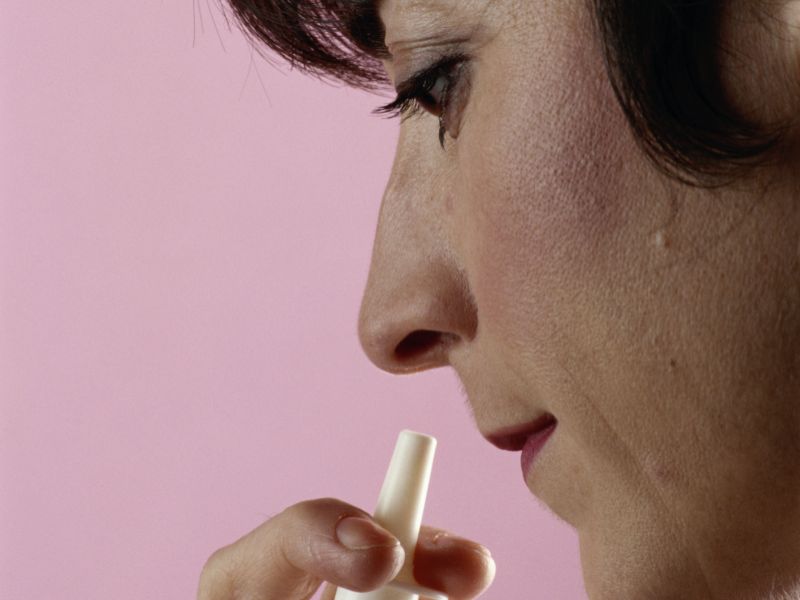TUESDAY, June 13, 2017 (HealthDay News) — For many people with diabetes, low blood sugar levels are a serious health risk, but researchers report that a new nasal powder quickly reverses the effects of this dangerous condition.
Better yet, it can be administered even when someone is unconscious, the researchers added.
The nasal powder contains the hormone glucagon. This hormone tells the body to release stored sugar, which will generally reverse a low blood sugar episode. Glucagon is currently only available in an injectable form that has to be mixed before it is injected.
“Family members can be terrified to use the injectable form. But 95 percent of caregivers found nasal glucagon very easy to use,” said study leader Dr. Elizabeth Seaquist. She’s directs the University of Minnesota’s division of diabetes, endocrinology and metabolism.
Seaquist is also a consultant for Eli Lilly and Co., which plans to make nasal glucagon; the company also makes injectable glucagon kits. The study was funded by Lilly and Locemia, the company that originally developed the nasal glucagon.
Low blood sugar, known as hypoglycemia, occurs when blood sugar levels drop too low. This can happen when someone with diabetes takes too much insulin (a hormone that allows the body to use sugar from food for energy). It can also happen if someone doesn’t eat enough or exercises harder or longer than planned.
Without enough sugar, the body and brain can’t function normally.
Low blood sugar can cause dizziness, hunger, confusion, blurred vision, sweating, slurred speech and irritability, along with other symptoms, according to the U.S. National Institute of Diabetes and Digestive and Kidney Diseases.
To treat low blood sugar, the person needs to have a drink or food containing a fast-acting sugar. Examples include fruit juice, soda with sugar, or sugary candy such as licorice (but not chocolate). Usually, blood sugar levels then quickly return to normal.
Left untreated, a low blood sugar episode will worsen. The continued lack of blood sugar may cause disorientation, seizures, unconsciousness and even death. If symptoms don’t subside, or the person is too disoriented to eat or drink, glucagon would usually be given.
The U.S. Centers for Disease Control and Prevention estimates that 300,000 people go to the hospital each year due to severe low blood sugar.
To evaluate the newly developed nasal glucagon, researchers gave people with type 1 diabetes a nasal device to use when they had a low blood sugar episode.
“Nasal glucagon is a dry powder that exists in a small device. It looks something like a nasal steroid inhaler, but smaller. To use, a family member or caregiver takes it out of the container, puts it in the nose and pushes the bottom of the canister… It’s absorbed through the nose into the bloodstream,” Seaquist explained.
Dr. Cristina Guzman, a study author and senior medical advisor for Eli Lilly, added, “Patients don’t have to breathe or inhale, which makes it easy to use.”
In the study, 69 people had 157 low blood sugar episodes that were treated with nasal glucagon. Their blood sugar levels ranged from 22 to 74 milligrams per deciliter (mg/dL) of blood. A level of 70 mg/dL or under is typically when a low blood sugar episode begins, according to the American Diabetes Association.
In 96 percent of the episodes, blood sugar levels returned to normal within 30 minutes, the study found. Side effects were similar to injectable glucagon, including nausea and vomiting. The nasal powder also caused some nasal irritation and headache. These side effects tended to last an hour or less, the study found.
Lilly hopes to submit nasal glucagon to the U.S. Food and Drug Administration sometime in 2018, according to Chad Grothen, global brand development lead at Eli Lilly. The company will likely seek approvals in other countries after the United States. Right now, the product doesn’t have a name, and Grothen couldn’t estimate how much it would cost once it hits the market.
Dr. Joel Zonszein, director of the Clinical Diabetes Center at Montefiore Medical Center in New York City, expects the new product will be expensive.
But, he said, it will also be welcome.
“The problem with the injectable is that even when [the caregiver] is taught how to do it, they rarely do it, even when the glucagon is available,” he explained.
“Nasal glucagon is easier to administer, is absorbed promptly and should be a good formulation,” he said.
Findings from the study were to be presented Monday at the American Diabetes Association meeting in San Diego. Studies presented at meetings are typically viewed as preliminary until they’ve been published in a peer-reviewed journal.
More information
Learn more about hypoglycemia from the U.S. National Institute of Diabetes and Digestive and Kidney Diseases.
Copyright © 2025 HealthDay. All rights reserved.

